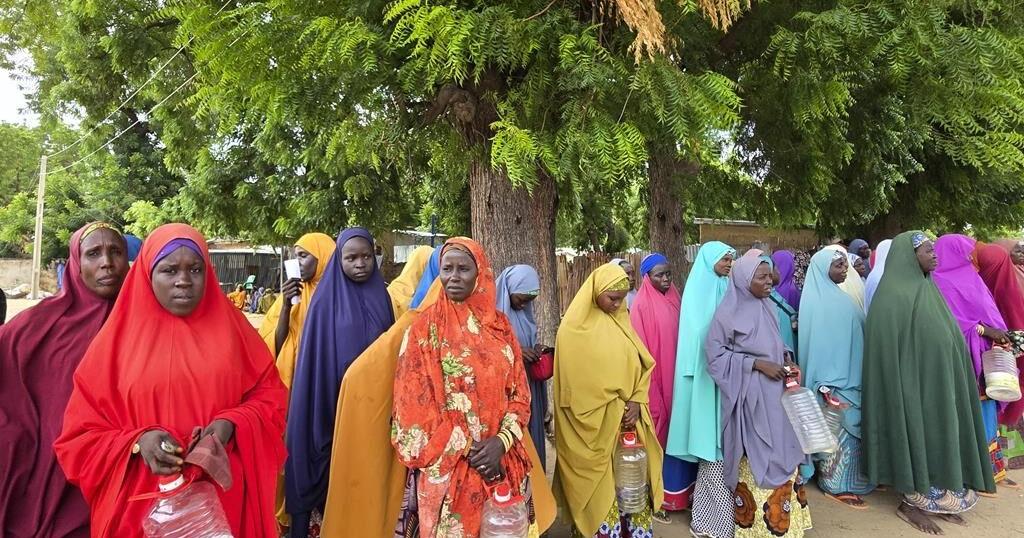DAMASAK, Nigeria (AP) — When Boko Haram launched an insurgency in northeastern Nigeria in 2010, Abdulhameed Salisu packed his bag and fled from his hometown of Damasak in the country’s battered Borno state.
The 45-year-old father of seven came back with his family early last year. They are among thousands of Nigerians taken back from displacement camps to their villages, hometowns or newly built settlements known as “host communities” under a resettlement program that analysts say is being rushed to suggest the conflict with the Islamic militants is nearly over.
Across Borno, dozens of displacement camps have been shut down, with authorities claiming they are no longer needed and that most places from where the displaced fled are now safe.
But many of the displaced say it’s not safe to go back.
Boko Haram — Nigeria’s homegrown jihadis — took up arms in 2009 to fight against Western education and impose their radical version of Islamic law, or Sharia. The conflict, now Africa’s longest struggle with militancy, has spilled into Nigeria’s northern neighbors.
Some 35,000 civilians have been killed and more than 2 million have been displaced in the northeastern region, according to U.N. numbers. The 2014 kidnapping of 276 schoolgirls by Boko Haram in the village of Chibok in Borno state — the epicenter of the conflict — shocked the world.
Borno state alone has nearly 900,000 internally displaced people in displacement camps, with many others absorbed in local communities. So far this year, at least 1,600 civilians have been killed in militant attacks in Borno state, according to the Armed Conflict Location and Event Data Project, a U.S.-based nonprofit.
And in a state where at least 70% of the population depends on agriculture, dozens of farmers have also been killed by the extremists or abducted from their farmland in the last year.
In May, hundreds of hostages, mostly women and children who were held captive for months or years by Boko Haram were rescued from a forest enclave and handed over to authorities, the army said.
In September, at least 100 villagers were killed by suspected Boko Haram militants who opened fire on a market, on worshippers and in people’s homes in the Tarmuwa council area of the neighboring Yobe state, west of Borno.
Analysts say that a forced resettlement could endanger the local population as there is still inadequate security across the hard-hit region.
Salisu says he wastes away his days in a resettlement camp in Damasak, a garrison town in Borno state of about 200,000 residents, close to the border with Niger.
Food is getting increasingly difficult to come by and Salisu depends on handouts from the World Food Program and other aid organizations. He longs to find work.
“We are begging the government to at least find us a means of livelihood instead of staying idle and waiting for whenever food comes,” he said.
On a visit last week to Damasak, Cindy McCain, the WFP chief, pledged the world would not abandon the Nigerian people as she called for more funding to support her agency’s aid operations.
“We are going to stay here and do the very best we can to end hunger,” McCain told The Associated Press as she acknowledged the funding shortages. “How do I take food from the hungry and give it to the starving,” she said.
Resettlement usually involves the displaced being taken in military trucks back to their villages or “host communities.” The Borno state government has promised to provide returnees with essentials to help them integrate into these areas, supported by aid groups.
The government says the displacement camps are no longer sustainable.
“What we need now is … durable solutions,” Borno governor Babagana Zulum told McCain during her visit.
As the resettlement got underway, one in five displaced persons stayed back in Maiduguri, the Borno state capital, and nearby towns but were left without any support for local integration, the Global Protection Cluster, a network of non-government organizations and U.N. agencies, said last December.
Many others have crossed the border to the north, to settle as refugees in neighboring Niger, Chad or Cameroon. The three countries have registered at least 52,000 Nigerian refugees since January 2023, according to the U.N. refugee agency — nearly twice the number registered in the 22 months before that.
A rushed closure of displacement camps and forced resettlement puts the displaced people at risk again from militants still active in their home areas — or forces them to “cut deals” with jihadis to be able to farm or fish, the International Crisis Group warned in a report earlier this year.
That could make the extremists consolidate their presence in those areas, the group warned. Boko Haram, which in 2016 split into two main factions, continues to ambush security convoys and raid villages.
Abubakar Kawu Monguno, head of the Center for Disaster Risk Management at the University of Maiduguri, said the best option is for government forces to intensify their campaign to eliminate the militants or “push them to surrender.”
After not being able to access their farms because of rampant attacks by militants, some farmers in Damasak and other parts of Mobbar district returned to work their land last year, armed with seedlings provided by the government.
Salisu was one of them.
Then a major flood struck in September, collapsing a key dam and submerging about 40% of Maiduguri’s territory. Thirty people were killed and more than a million others were affected, authorities said.
Farms that feed the state were ruined, including Salisu’s. His hopes for a good rice harvest were washed away. Now he lines up to get food at a Damasak food hub.
“Since Boko Haram started, everything else stopped here,” he said. “There is nothing on the ground and there are no jobs.”
Maryam Abdullahi also lined up at a WFP hub in Damasak with other women, waiting for bags of rice and other food items she desperately needs for her family of eight. Her youngest is 6 years old.
The donations barely last halfway through the month, she said, but she still waited in the scorching heat.
What little money she has she uses to buy yams to fry and sell to sustain her family but it’s nowhere enough. Her only wish is to be able to get a “proper job” so she and her children would feel safe, she said.
“We either eat in the morning for strength for the rest of the day or … we eat only at night,” Abdullahi said.
___
Associated Press reporter Haruna Umar in Maiduguri, Nigeria, contributed to this report. contributed.
___
The Associated Press receives financial support for global health and development coverage in Africa from the Gates Foundation. The AP is solely responsible for all content. Find AP’s standards for working with philanthropies, a list of supporters and funded coverage areas at AP.org.

























